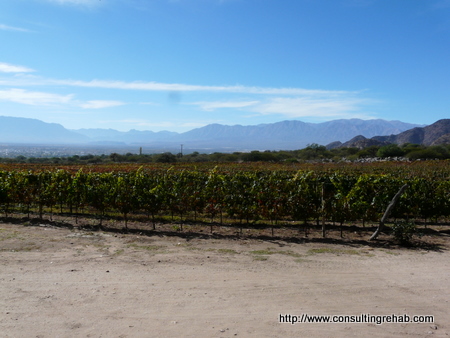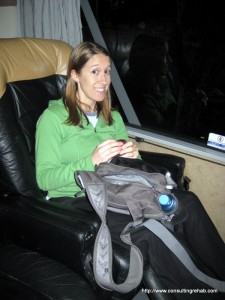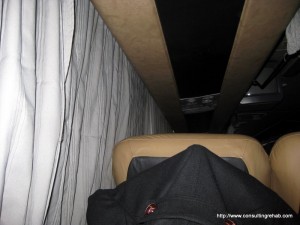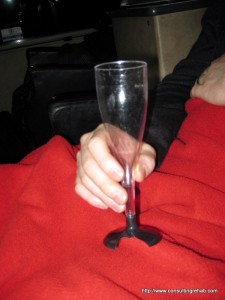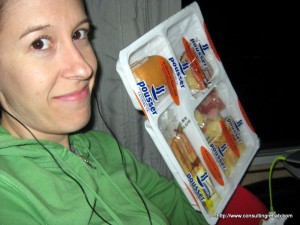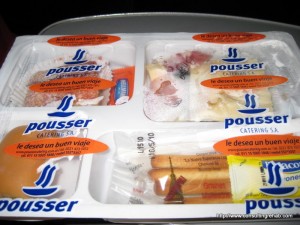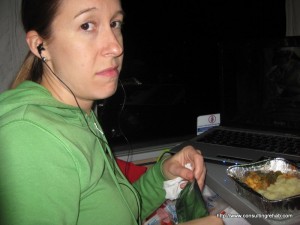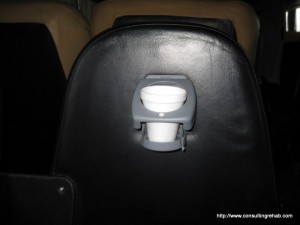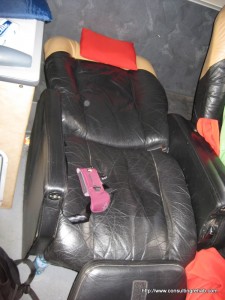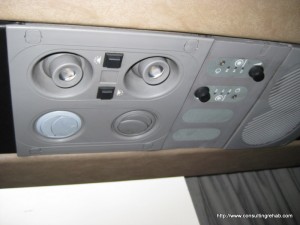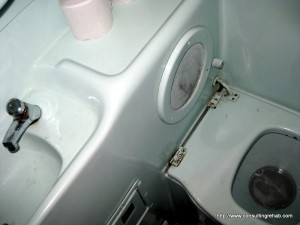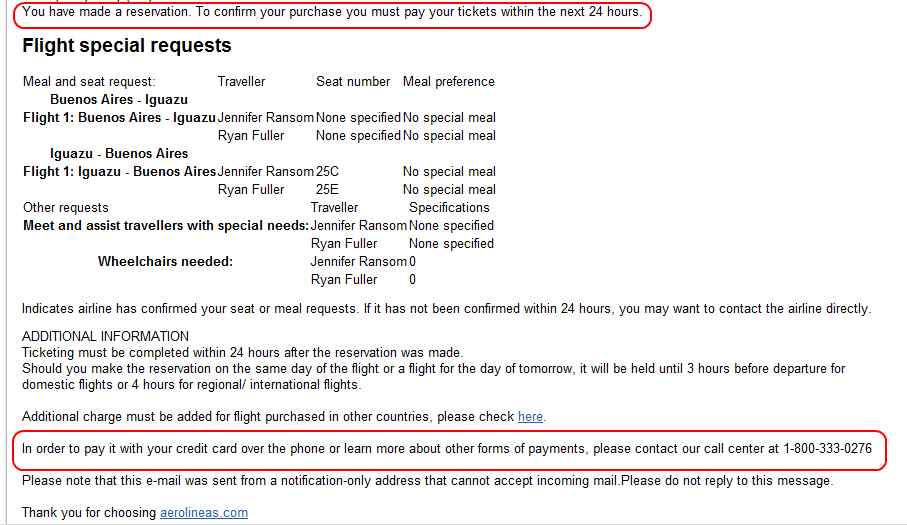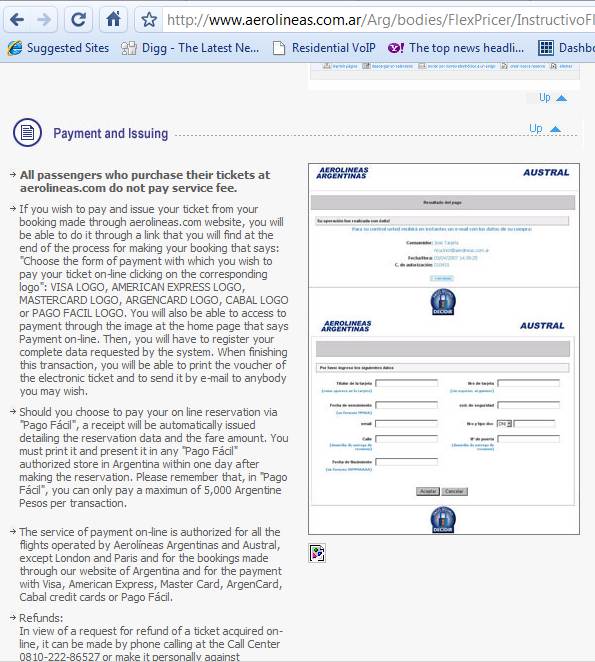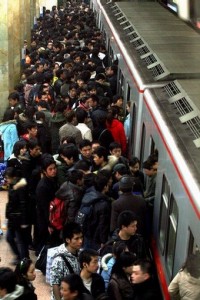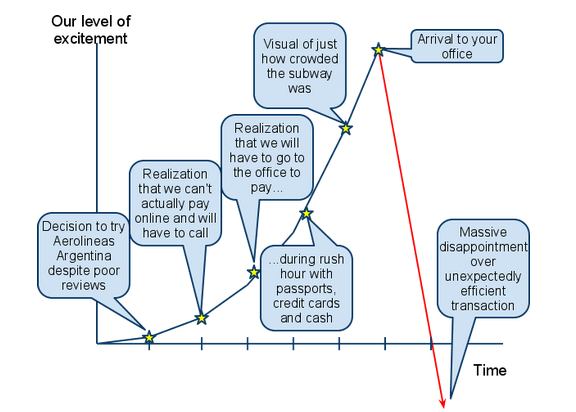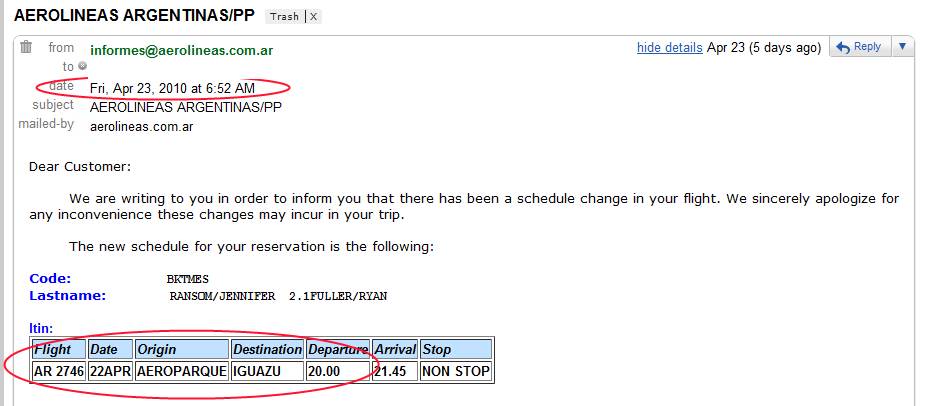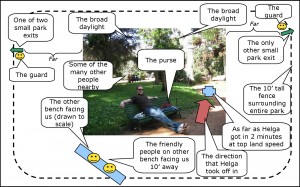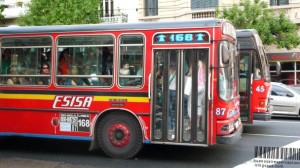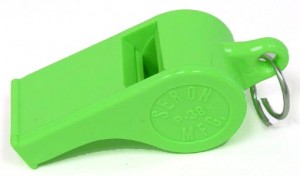We just got back from a weeklong trip to Salta and northwest Argentina, and let’s just say that we’re very appreciative of all that Buenos Aires has to offer. We’ve heard that the rest of the country thinks porteños are snobby and that, in reverse, porteños think people from the provinces are unsophisticated and that Buenos Aires is far superior. Got to say, we’re starting to feel more like porteños every day . . . .
Our itinerary took us to see the top sights in northwest Argentina: Valle de Calchaquí, the wine-producing town of Cafayate, the salt flats of Salinas Grandes and the small village of Purmamarca (as well as the two biggest cities in the region, Salta and Jujuy). As you know from Ryan’s previous post, we made the mistake of using a local guide for the first two sights, then covered the rest on our own.
Salta
After our epic 20-hour journey on FlechaBus, we were very eager to arrive in Salta and check in to our hotel. We had heard that Salta is a beautiful and charming city, so we were excited to see it for ourselves. It has a wonderful central plaza surrounded by colonial buildings that are artfully lit at night. But we were somewhat surprised to find that the city is dirty, noisy and really polluted – Buenos Aires is a far bigger city, but the pollution was much worse in Salta.
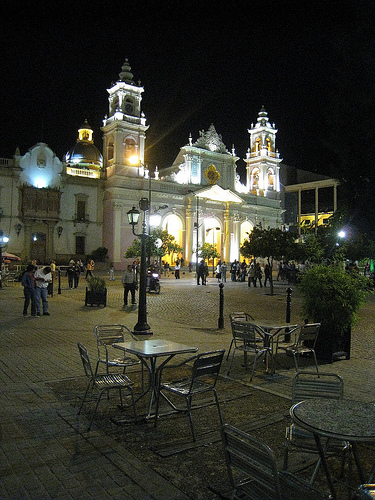
Salta's main plaza is surrounded by lovely colonial buildings. They've got the lighting thing down for sure.
The Salta region is famous for its empanadas, and we ate them at least once (sometimes twice) every single day that we were there (to be fair, partly because they were good, and partly because there weren’t many other appetizing options). The best we had by far were at the Doña Salta restaurant just down the street from our hotel in Salta – yum!!

We love to eat empanadas as much as we love to play with them!
Valle de Calchaquí
The scenery on the drive to Cafayate through the Valle de Calchaquí is truly amazing – a beautiful landscape as far as the eye can see. Some parts were red, others dusty brown and even green. The colors kept changing around every turn.
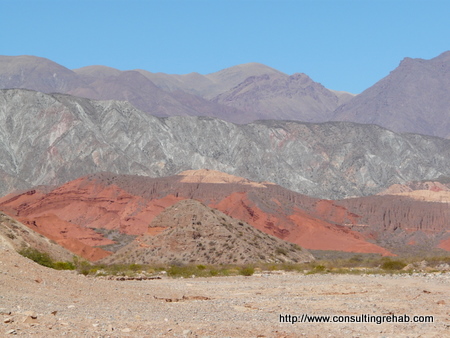
These hills had just about every color you could imagine
The drive takes somewhere around 3 hours, depending on how often you stop. We stopped to explore the Garganta del Diablo (interestingly, we’ve identified at least 3 other places in Argentina with the same name, including the crazy 3-sided waterfall we saw at Iguazu) – a huge canyon in the red rocks right off the highway. Ryan climbed up a ways, and I graciously offered to stay below and take pictures (had nothing to do at all with my fear of heights).

Um, this is really high . . . not sure how I'm going to get down
Wine country of Cafayate
Once we arrived in Cafayate, we checked in to our hotel – the Patios de Cafayate (a Starwood luxury property) that used to be the estate of a winemaker’s family – the winery is still operating and is attached to the hotel. The property is absolutely beautiful, but they’re definitely missing the mark on some of the basics to make this hotel truly as spectacular as it could be (review of Patios coming soon).
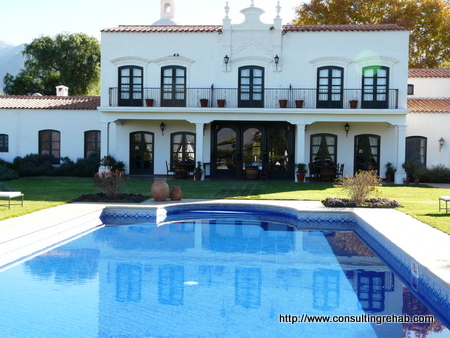
We like pretty hotels
Cafayate is one of Argentina’s wine-producing regions, known for having fuller-bodied wines than those produced in Mendoza – one of our favorite everyday wines is from Cafayate (Quara malbec, 14 pesos/bottle – that’s around US$4). We tasted at two wineries in Cafayate chosen by our guide and were underwhelmed by both. Domingo Hermanos is located right in town and had a very basic tasting room pouring very mediocre wines (and only 2 of them!).

Wine by the gallon - got to be good
Finca de las Nubes is located just outside of town at the base of the hills. Their property is charming and has a great view, but their wines leave something to be desired. Impressively though, the entire winery is operated by just 5 employees – we saw them applying labels by hand while we were there.

Not a bad view from the winery, even though their wine sucks
Despite our disappointing tastings, we did discover a few great new malbecs while we were there – we haven’t seen these wines in Buenos Aires (though we didn’t know to look for them) so bought a few bottles to bring back with us just in case. Interestingly, we learned that the wines that are available in Buenos Aires are actually significantly more expensive in Cafayate (we saw our aforementioned-standby Quara priced at 25-30 pesos in the wine shops vs. 13 pesos in the big city). Wouldn’t you think they might be cheaper closer to the source, before all the shipping and logistics expenses? Clearly not.
Cafayate itself is a small town – the central plaza is quaint, surrounded by restaurants and shops. We ate at Colorado (owned by 2 Americans who relocated to Cafayate) and Terruno (located on the plaza, relatively good food). There are a handful of wineries/tasting rooms in town and a shop selling homemade alfahores – you can’t miss the massive sign from the main plaza. We bought an assortment to take back to our Spanish teachers in Buenos Aires for our ongoing debate over the best alfahores and conitos.

Ok, so we bought more than a few, but it's for research!!
One other unique activity in Cafayate is to visit the goat cheese farm on the outskirts of town, where we met some of the producers. Our tour of the farm in Spanish was ok, but turns out our goat-farm vocabulary isn’t that great. Go figure.

Hello - I'm a goat and these are my friends
Renting a car
After heading back to Salta for one more night, ditching our guide and reserving a rental car, we were ready to hit the road and explore the region north of Salta. Neither of us had driven in foreign countries before (Canada and Mexico don’t count) and were a little nervous about renting a car and driving to the middle of nowhere. We were lucky to quickly find a car available through Alamo, who we’d read good reviews about. The employees we dealt with were all great – excellent English and very good customer service. It was a bit scary driving in Salta and trying not to get run over by buses, but once we made it out of the city we were good to go.
We hit Jujuy on our drive up to Purmamarca, our base for the next two nights. While some friends rave about the city of Jujuy, to us it just seemed like a biggish, mediocre city in the mountains. We stopped and had pizza for lunch at Chung-King (yep, that’s actually a pizza place, and no, they don’t serve Chinese food at all) and that was enough of Jujuy for us.
Purmamarca
Purmamarca is this cute little village up in the mountains. It’s one of the most popular places to overnight if you’re visiting the region north of Salta, partly because it’s developed a bunch of restaurants and hotels, and partly because it’s situated right at the base of this really pretty hill.
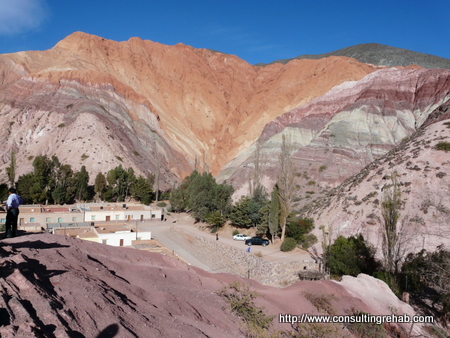
See, I told you it was a pretty hill
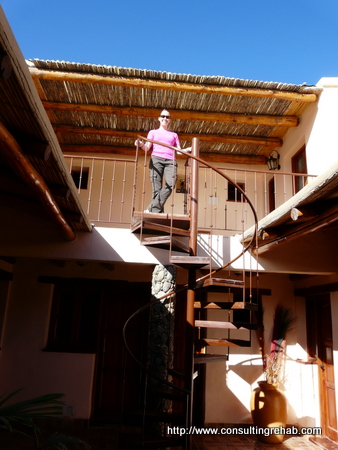
And our room on the top floor had a view of the hills (and a broken shower . . .)
Salinas Grandes
We’d read that the massive salt flats were not to be missed and also that they were best viewed toward the end of the day, after all the tour buses have left. So we cut short an intense game of chess in a café in Purmamarca and hit the road. And not just any road. It’s a 1-hour series of switchbacks straight up the side of the mountain to 12,000-ish feet. With tour buses and big trucks barreling down at us. Fun.
So after this lovely drive, we made it to the salt flats just as the sun was going down. Here’s our take on the famous Salinas Grandes: big, wide open space that’s white and crackly-looking. Kind of cool? Yes. Worth 2 hours of driving on scary mountain roads, the last bit in the dark? Maybe not. But we did take a few of the obligatory pics while we were there.
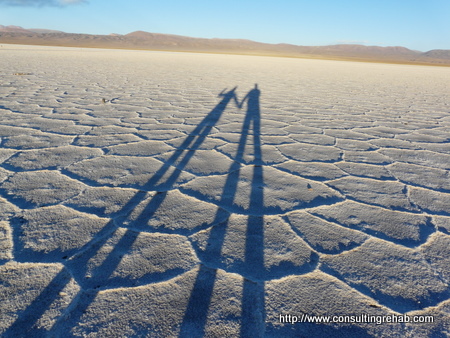
Hello from the really tall shadow people
Probably the most fun part was sneaking in to use the fee-for-use porta-potty after it was closed, then being confronted by a grumpy saltminer wanting her 1 peso on the way out. We were happy to pay, but it’s not our fault she didn’t have change for a 5!
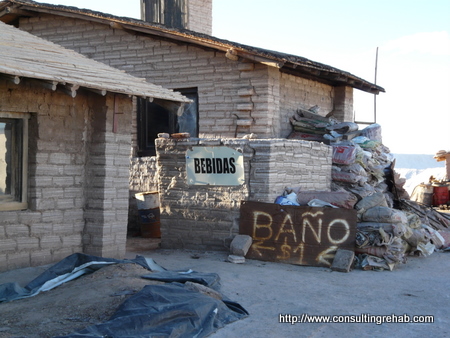
You know this is going to be a classy bathroom with a sign like that
Humahuaca and Tilcara
These are two of the town that are regularly mentioned as destinations on any tour of the northwest. The drive to visit them was interesting, but if you’ve spent time in Northern California, Washington state or anywhere with mountains, I don’t think you’d be blown away. Maybe people get excited by the drive there? To us, it was ok, but not exactly a must-see.
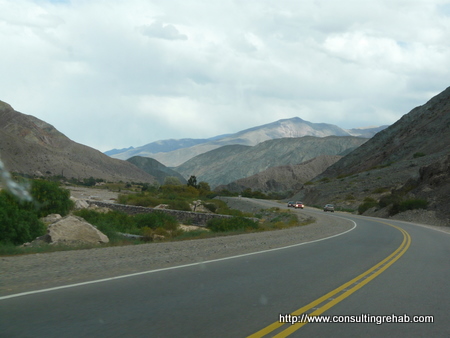
It's a nice change from the city, but it's not exactly the most amazing landscape we've ever seen . . .
Maybe it was the towns themselves? We didn’t even stop in Humahuaca – just drove through and were ready to head back. It was interesting to see an Argentine pueblo, but there are plently of those that aren’t hours from anywhere. Tilcara was a little better. After walking for 10 minutes or so, we had pretty much seen the town so found a place to have lunch (empanadas – what else?) and a café, then headed back to our base in Purmamarca.
Heading home
On Sunday, it was time to make the trek from the small pueblo of Purmamarca in the hills all the way back to the big city of Buenos Aires. Our drive to the Salta airport took ~3 hours, leaving us with plenty of time before our flight. After our previously-posted experiences with FlechaBus and Aerolineas Argentinas, we were done taking chances on our transportation and booked a flight back with LAN. And what a good decision that was!!!!!
In comparison with our experience on Aerolineas Argentinas: LAN promptly checked us in (no waiting in line for 45 minutes because the computers were down and they were trying to come up with a back-up plan on the spot – see AA post). They made announcements in Spanish and English, didn’t combine our flight with another flight going to a different city, didn’t cancel all seat assignments, didn’t even land in another city that wasn’t on the itinerary (in case you’re wondering, yes, every one of these things happened when we flew with Aerolineas Argentinas to Iguazu). Instead, we boarded our flight on time and in an orderly fashion and actually pulled back from the gate 3 minutes EARLY. We landed in Buenos Aires, promptly received all of our checked luggage and were on our way home.
All in all, it was a fun trip and nice to experience a different part of the country. At the same time, it didn’t quite measure up to all the hype that we’d read and heard. It’s a great place to see if you’re in the area, but I wouldn’t call it a must-see international destination. Some of the landscapes are beautiful (valley on the way to Cafayate) and it was wonderful to visit a few villages that are on the other end of the spectrum from life in BA.
Buenos Aires, we missed you.








